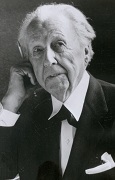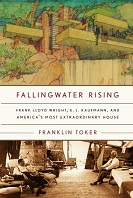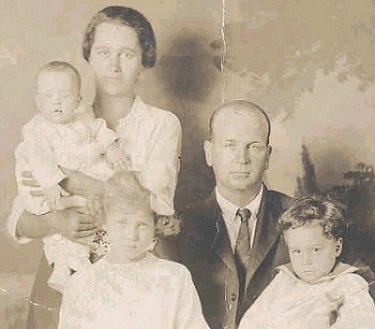
.
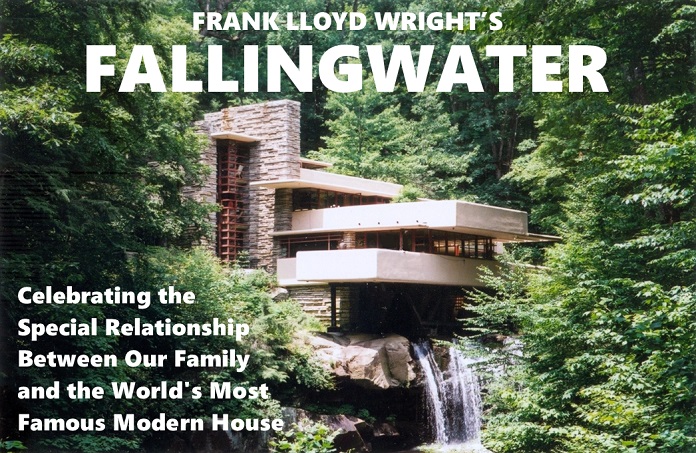 |
.
See also: Images of Bear Run in the Years Before Fallingwater and Fallingwater Today
By Mark A. Miner
|
| Frank Lloyd Wright Courtesy PBS |
Today, the house is owned by the Western Pennsylvania Conservancy and has been named to the World Heritage List of the United Nations Educational, Scientific and Cultural Organization (UNESCO).
The house is just four miles (as the crow flies) from where our pioneer ancestors, Revolutionary War veteran Jacob Minerd Sr. and his wife Maria settled in 1791 on the mountaintop border of Fayette and Somerset Counties, PA.
During the decades since Fallingwater was built in 1936-1937, our extended family has played a unique role with its construction, care, conservation and interpretation. At least 26 have worked with the house in some capacity; two are believed to have helped build the house; at least four were active employees when the house was still privately owned; and the families of two lived on the property in private dwellings.
|
| Book naming 5 cousins |
This report, published for our clan’s 2004 national reunion, delves deeper into our family’s role. It primarily focuses on these employees during the 1955 to 1959 era – Ralph Miner, Frank Miner, Lester Miner and Oakey Harbaugh.
The report initially was based on 15 years of correspondence and visits with cousins; research of newspapers and books; and the Fallingwater Archives. Much of this material was first published in a booklet for the 2004 family reunion. The reunion in turn led to an Associated Press story distributed throughout Pennsylvania, headlined "Celebrating Fallingwater: Family Members Recount Long Ties to Wright's Masterpiece."
~ What We’ve Learned ~
We have learned important lessons as a result of this research:
-
The Kaufmanns took great care of their employees and the community at large;
-
Employees had great admiration and affection for the Kaufmanns, taking their roles very seriously;
-
Employees were provided with excellent tools and technology for their work to maintain the house and grounds;
-
The family’s collective labors during the transitional period of 1955 to 1963 – between when Edgar Kaufmann Sr. died and when his son Edgar Jr. deeded it to the Conservancy – have protected and preserved an architectural masterpiece. Today Fallingwater is toured by more than 144,000 visitors annually and has been designated as a national historic landmark.
~ A Momentous Meeting in 1955 ~
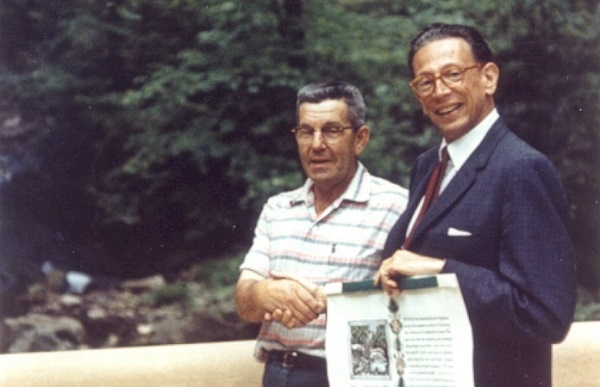 |
| Ralph Miner with house owner Edgar Kaufmann jr., 1965 Courtesy the late Donna Marie Miner |
On Aug. 29 1955, a meeting took place at Fallingwater that had a far-reaching impact. New owner Edgar Jr., who had inherited the house just four months earlier, was living full-time in New York City, where he was director of the Industrial Design Department at the Museum of Modern Art (MOMA) and art editor for the Encyclopedia Britannica. He was primarily using Fallingwater as a weekend and vacation retreat, and needed to make sure his beloved house would be properly managed in his absence.
Thus, Edgar Jr. summoned three Fallingwater employees to a meeting to agree on responsibilities for ongoing care, maintenance and preservation. The team included our cousin Ralph Miner as well as George B. Green and Jesse Hall. Edgar Jr.’s secretary, Ethel Clinton Appel, also attended.
At the meeting, Ralph was named Manager of Maintenance. He was responsible for windows and screens, the old pool, greenhouse maintenance, the Kaufmann crypt, and other buildings and interior roads on the property.
Mrs. Appel agreed to travel from her Pittsburgh office to Fallingwater every two weeks, talk to the key managers about projects and priorities, and send detailed reports to her boss in New York. Much this report is drawn from Mrs. Appel’s firsthand reports from 1955 to 1959, found today in the Edgar J. Kaufmann Sr. papers at Fallingwater.
~ Ralph Miner ~
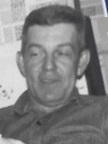
Ralph Miner
Ralph Miner (1910-1983) and his wife Mary "Leola" (Skinner) Miner (1912-2002) lived in Mill Run. He was the son of William Henry “Squire” and Sara (Basinger) Minerd.
He began working part-time for the Kaufmanns in the 1930s, later becoming full-time. In 1956, he and Leola moved into a renovated house on the Fallingwater property. They remained there until his retirement in 1973.
Ralph’s work can be summarized in several key themes:
Desire to Be of Service – Ralph's widow Leola was interviewed in 1997 for a Fallingwater oral history project, and her comments were on display at the 2004 “Fallingwater Home Coming” exhibit. She said her husband “really tied himself down” to the house “because he felt responsible.” He was not comfortable taking vacations or attending family outings or church activities for fear that he might be needed for an emergency project.
One of the Appel reports (Oct. 11, 1955) gives insight: “Ralph was busy working on the pool for this week-end and plans to look after the driveways, paint around the new steps, and have everything in apple-pie order for your guests… We do want everything just so …. Your happiness is uppermost.”
.
Friendship with Edgar Kaufmann Jr. – Ralph relished his personal friendship with his boss, Edgar Jr. This is clear in many comments found in the Appel reports:
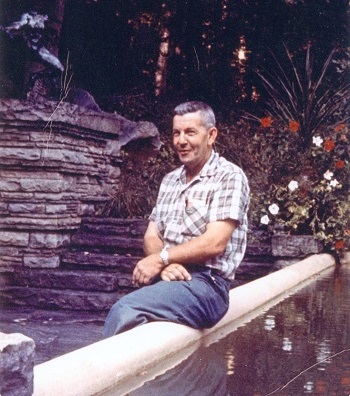
Ralph Miner at the guest house pool. Note the Statue of
Iris at upper left. Courtesy the late Donna Marie Miner
-
“Mr. Kaufmann personally went through the woods with Ralph and pointed out various things he would like done.” (Aug. 19, 1958);
-
Ralph was “very pleased that Mr. Kaufmann had been so attentive during his illness.” (March 16, 1959);
-
“Ralph could hardly wait to tell me how much he enjoyed cutting brush with Mr. Kaufmann. He thoroughly enjoyed it and was convinced Mr. Kaufmann knew how to work in the woods.” (July 14, 1959).
Care of Precious Artwork – The Kaufmanns were collectors of rare, priceless artwork that they displayed throughout their Fallingwater home. Ralph had responsibility for helping to care for these one-of-a-kind masterpieces.
-
In December 1955, he helped build special crates for “standing figures by Henry Moore” that were shipped to “Miss Chaflin at Vassar.”
-
In November 1957, ornate bronze doors by Italian artist Alberto Giacommetti were delivered to be hung at the crypt. Ralph was in charge of the work. The following month, Mrs. Appel reported: “I was very pleased with the crypt doors. The men will have all that work completed this week.”
-
Another of the Kaufmann artworks, “Mother and Babe” by Jacques Lipchitz, was on display in August 1956 when a freak storm of high winds and water caused great damage to the house. The statue was swept away by the swollen, raging Bear Run waters. In her report, Mrs. Appel reported: “No trace of the statue (mother and babe) has been found, nor the man on the horse (other than one of the horses legs broken off). Ralph intends making a thorough search tomorrow and will ‘phone me if he finds the former statue.” (Aug. 20, 1956).
Cleanup After Damaging Flood of 1956 – In June 1956, Ralph oversaw the erection of scaffolding around Fallingwater to begin a massive painting effort. When the flash flood struck in August, the scaffolding was caught in the wind and “shook the whole house,” according to Donald Hoffmann’s 1978 book, Frank Lloyd Wright’s Fallingwater: The House and Its History.
Ralph and his men faced a huge task of cleanup and repair. Mrs. Appel reported: “[Ralph] was planning to finish Jesse Hall’s house this week … but with the terrible flood damage, I am sure he has found it necessary to cast aside his plans and help cleaning up…. It was truly heart-breaking to helplessly stand by and see what was happening. I can’t describe what happened at our place.”
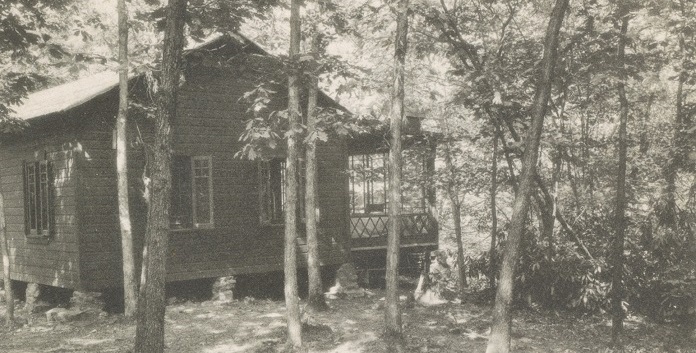 |
| The Kaufmanns' beloved, rustic "Hangover" cottage on the property, which Ralph helped demolish |
Demolition of “The Hangover” – “The Hangover” was a beloved, rustic cabin built by the Kaufmanns in 1921. They used it as their residence when visiting Bear Run on weekends and vacations in the years before Fallingwater was built. By the 1950s, it had fallen into disrepair. In 1957, at Ralph’s urging, Edgar Jr. consented to its removal. The Appel report of March 26, 1957 states that Ralph’s men “were working on demolition of the Hangover … another 2 days and it will be all down. Everything has been carefully stored in the barn and Ralph has so recorded it in his book.”
As Tour Leader – By 1956, public demand to see the house was high. Toker’s book states that Ralph was given the responsibility for leading house tours. He conducted “45 minute tours, but banned photography when it dragged out the visits to three times that length.” Ralph collected small fees and prepared reports for his boss listing tourists’ names. When some visitors abused their privileges, Edgar Jr. made a new rule that there was to be “no one inside the house on Thursdays or Friday, … and no little peeks or squints inside.” During 1957, more than 300 visitors went through the dwelling. In the period June-September 1958, Edgar Jr. decreed that the house was to be entirely “closed to visitors.”
Work at the House – Over the years, Ralph and his crews were involved with many interior and exterior repairs and renovations to Fallingwater itself. Without going into great detail, some of these efforts included painting, heating, lighting, waterproofing, utilities, removing brush and roof repair. In one notable example, he and Earl Friend repaired a small dam and frozen water line in the dead of winter. They waded into the stream “through the ice to their waist” and slipped and fell several times before finding and fixing the problem.
.
~ Franklin "Frank" Miner ~
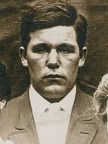
Frank Miner
Frank Miner (1893-1956) was Ralph Miner’s eldest brother and were 17 years apart.
Born in Wilmerding, PA, when his father was there employed by Westinghouse Electric Company, they returned to Mill Run, where Frank grew up. He was twice married, to Ida B. Grimm and Bertha C. Basinger. Between them, a baker's dozen children were born.
Frank was a veteran of World War I. He earned a living at Fallingwater from the 1930s until his untimely and unexpected death in 1956. He is mentioned throughout the Appel papers.
Among the projects Frank worked on were:
-
Steps at Fallingwater, painting the swimming pool pipe, working on driveways and the dam, and tearing down the Watson house. (Sept. 12, 1955); ;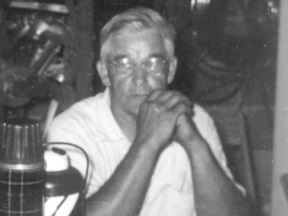
Frank Miner
-
A pipeline from the greenhouse to the garden (Nov. 8, 1955);
-
Working at the barn near Mrs. Appel’s house (Jan. 23, 1956); and
- Sanding floors and removing a door of the Merle Taylor house (April 17, 1956).
Sadly, Frank passed away suddenly on June 4, 1956, after working a full day. He was laid to rest in the Normalville Cemetery. His obituary in the Connellsville Daily Courier noted that Frank “died suddenly ... in a Normalville store after suffering a stroke… He had been employed at the E.J. Kaufman estate...”
In her report of June 4, Mrs. Appel wrote: “We were all shocked and saddened to learn of the sudden death of Ralph Miner’s brother Frank, one of our workmen… Flowers were sent [from] Mr. Kaufmann.” Two men were hired to replace Frank. He is mentioned and pictured in the 1970 book, A History of Mill Run.
~ Lester Miner ~
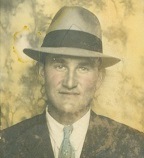
Lester Miner
Lester Miner (1908-1981) was another of Ralph Miner’s elder brothers, but only separated in age by two years.
He also worked at Fallingwater in the mid-1950s. His boss, George Green, had responsibility for managing the grounds around the house, greenhouse, gardens, trees and landscaping.
Lester often supervised the crew when Green was absent. The Appel papers cite his work activity as follows:
- “Miner’s men had just completed several new glass sashes and repaired several old ones for Mr. Green’s boxes. Also … four large oak containers made by Miner’s men for Mr. Green to plant small evergreens in for the big house.” (Nov. 6, 1956);
- “Lester Miner worked an extra day (Sunday) during the past pay period – this was due to Mr. Green’s illness and Mr. Miner came and watered the greenhouse plants and looked after things.” (June 5, 1958); and
- “Lester Miner will work 7 days a week – coming on Sundays to regulate the heat of the green house, according to the temperature and to water the greenhouse plants.” (Aug. 19, 1958).
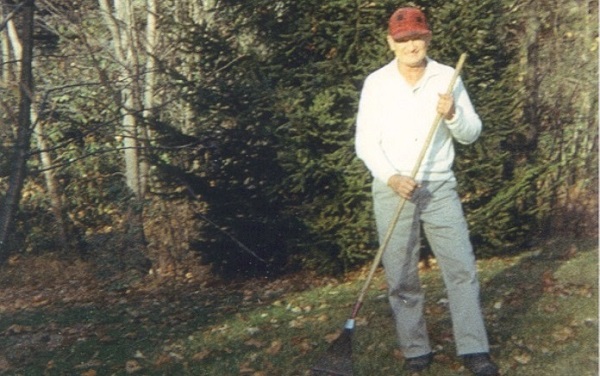 |
| Lester Miner |
After Lester died in 1981, his wife Mildred (Anderson) Miner (1920-1993) began working at Fallingwater’s Child Care Center. She spent a decade directing the Center and retired at the end of 1991. Their daughter Gail and granddaughter Candi have worked there too – the third generation of service caring for the children of Fallingwater’s visitors.
Lester and Mildred both are mentioned in the 1970 book, A History of Mill Run.
~ Oakey David Harbaugh ~
|
| Gertrude and Oakey Harbaugh, Evelyn, Lester, baby Gladys |
Oakey David Harbaugh (1894-1975) was born on a farm in Maple Summit in the mountains above Mill Run.
He was part of the large branch of Harbaugh cousins in the family. So was his wife, Gertrude Shroyer (1897-1978), a native of the nearby community of Clay Run.
They both traced their lines back to David and Mary Magdalene (Whipkey) Harbaugh, the father a veteran of the Civil War. Both were considered part of the Fallingwater team and both mentioned in the Appel reports.
Oakey began working at Fallingwater in about 1949. His boss was Jesse Hall, who managed the Kaufmann farm and sawmill on the sprawling estate.
His first mention in the Appel reports is Jan. 23, 1956 – “Oakey Harbaugh was cleaning in the barn and had 50 dozens of eggs ready for us to bring to the office. People clamor to buy them.”
Other mentions include:
- “Oakey and Merle were making hay today … 36 acres of hay – 2 tons to an acre … so they plan on having 72 tons of first cutting of hay. There is 8 acres of wheat to be harvested and they have 16 acres of corn to plow and hoe…. The barn is exceptionally clean.” (July 2, 1956);
- “At Harbaugh’s Oakey was sorting bushels and bushels of corn – there is about 500 bushels - this corn was not raised this year … it is old corn. Oakey was sorting the good from the moldy.” (Dec. 17, 1957);
- Gertrude killed and dressed 38 of the old hens, sold to several buyers, including the Ohiopyle Hotel. She also sold 12 live hens to her son, Lester. (Nov. 11, 1958);
- Was loading/unloading lumber cut at the sawmill for flooring for the new chicken coop. (March 16, 1959);
- Helped plant 50,000 pine trees on the property. “They are being planted in every field on the Tissue farm and what is left over will be planted on the Bowers farm.” (March 30, 1959);
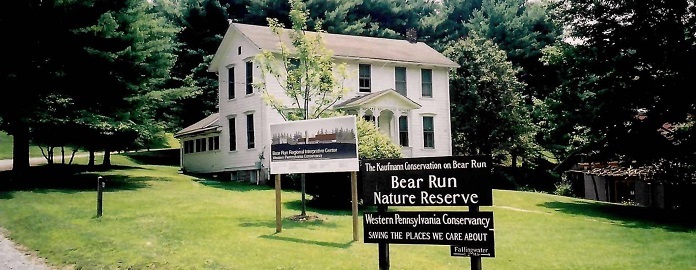 |
| Above: the farmhouse where the Harbaughs lived, next to the Kaufmann barn (below) along today's Route 381 |
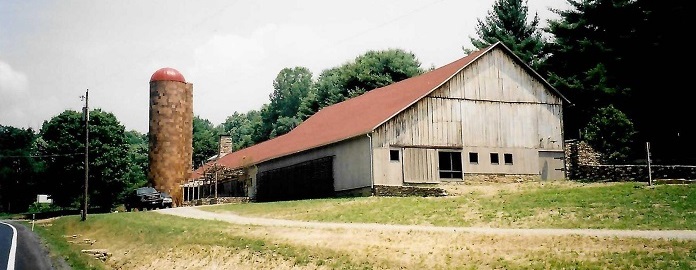 |
- Gertrude “was killing the young roosters for Fallingwater deep freeze.” (July 14, 1959); and
- “The new chickens are now starting to lay – Jesse has arranged with an ice cream company in Connellsville to sell the eggs to them. [A] control book should be purchased and given to Oakey Harbaugh so that a daily record of the number of eggs laid could be kept.” (Aug. 17, 1959).
They are mentioned in the 1970 book, A History of Mill Run.
~ Daniel McKinley Burkholder ~
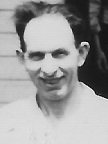
Daniel Burkholder
Daniel McKinley Burkholder (1900-1988) was married to Kathryn Miner (1895-1985), the sister of Ralph, Frank and Lester.
He is believed to have worked as a laborer during construction of the Fallingwater house circa 1936-37. Nothing further of his involvement is known.
~ Lester Harbaugh ~
Lester Harbaugh (1919-1987) was the son of Oakey and Gertrude Harbaugh. He is said to have worked as a general laborer during construction of the house.
~ Lawrence Earl Minerd ~
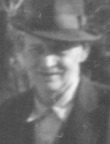
Lawrence Minerd
Lawrence Earl Minerd (1887-1972) was the son of Calvin and Mary (Means) Minerd Sr.
During the period of time of Fallingwater's construction, he worked at a stone quarry near the Cross Roads area of Bullskin Township north of Connellsville, PA.
It is said that he or his employer offered to furnish flagstones for the patios of Fallingwater, although the materials may not have been accepted for use..
~ Lewis C. Ohler ~
Lewis Cecil Ohler was married to Daniel and Kathryn (Miner) Burkholder’s daughter Helen. He also worked during the construction phase of the house, helping to quarry stone from nearby sites. He also handled stonework and plumbing services.
~ A Generous Gift to the Community ~
After reviewing Ralph Miner’s proposed Fallingwater maintenance budget for 1959, owner Edgar Kaufmann Jr. felt the amount was too high. He asked Ralph to trim back the cost of supplies “without too much affecting the excellent results that you have been able to achieve, and that are the source of much pleasure and favorable comment.” Edgar proposed that any funds saved would be donated “to any church or school you name … and of course give it in your name, or have you transmit the check.” That year, according to family notes, “Each church in Mill Run received $750.” The arrangement continued until at least 1961.
~ 27 Other Cousins, Past and Present ~
|
|
.
| Copyright © 2004, 2021-2024 Mark A. Miner. Reproduction forbidden without permission. |
| Quotations from the Ethel Clinton Appel reports (Edgar J. Kaufmann Jr. Papers) and Fallingwater Oral History Project courtesy of the Western Pennsylvania Conservancy. |
